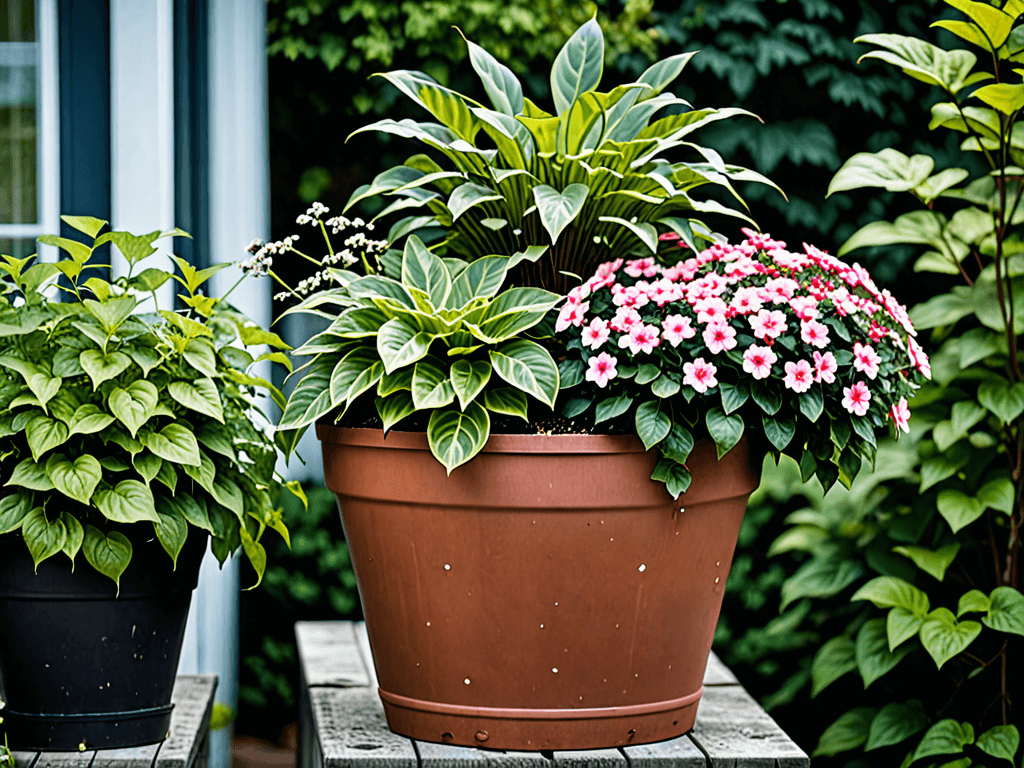Container gardening is a versatile and accessible way to breathe life into any space, big or small.
With the rise of urban living and limited outdoor spaces, more people are uncovering the joys and benefits of this gardening style.
From choosing perfect containers to mastering plant care, there’s much to explore in this fulfilling hobby that combines innovation with nature.
Understanding Container Gardening
Container gardening is a method of growing plants exclusively in containers instead of directly in the ground. This approach allows for flexibility in garden design and placement, making it ideal for urban and small spaces. Containers can range from traditional pots and planters to more unconventional items like barrels or even old boots!
This gardening style supports diverse plant species, including vegetables, herbs, flowers, and shrubs. One major benefit is the ability to control soil quality and conditions, which leads to fewer weeds and pests.
Moreover, container gardening offers portability; plants can be moved to catch seasonal sunlight or be taken indoors to escape frost. Whether you’re a seasoned gardener or a beginner, understanding the basics of container gardening opens a world of creative gardening possibilities right at your doorstep.
Benefits of Container Gardening
Container gardening offers numerous benefits for both novice and experienced gardeners. One significant advantage is the ability to optimize space, making it a perfect choice for urban environments or small areas like balconies and patios.
This method allows for better control over soil quality, helping prevent the growth of weeds and reducing pest issues, which can lead to healthier plants.
Additionally, container gardening is versatile and flexible; you can reposition plants to take advantage of sunlight, shelter them during adverse weather, or even rotate them for aesthetic appeal in your space.
Watering and fertilization can be tailored to each plant’s specific needs, ensuring they receive the exact care they require.
Perhaps one of the most rewarding aspects is the ease of access to fresh herbs, vegetables, and flowers just steps away from your door, which encourages sustainable living and a closer connection to nature.
Choosing the Right Containers
Choosing the right containers is crucial for successful container gardening. The container needs to have good drainage to prevent waterlogging, which can harm plant roots.
Materials like clay, ceramic, and plastic each have their pros and cons. Clay pots are porous and allow for breathability, but they can dry out quickly and are heavier.
Plastic pots are lightweight and retain moisture well but may not provide sufficient air circulation.
It’s also important to consider the size of the container; it should be large enough to support the mature size of the plant’s roots.
Self-watering pots can be beneficial for those who might forget to water regularly.
Additionally, the color of your container can affect the soil temperature, with darker colors absorbing more heat and possibly affecting plant growth.
Finally, aim to choose a container style that complements your home aesthetic, turning your garden into a visual delight.
Best Plants for Container Gardening
Choosing the best plants for container gardening depends on your local climate and the space you have available.
Herbs such as basil, chives, and parsley thrive well in containers and are perfect for any size garden.
Leafy greens like lettuce and spinach are also ideal as they grow quickly and don’t require deep containers.
For those interested in a spurt of color and fragrance, annual flowers like petunias and marigolds can brighten up any space.
Certain vegetables like cherry tomatoes and peppers are particularly suited for container growth, providing a rich harvest throughout the season.
If you’re looking to grow fruits, strawberries and dwarf citrus trees can be rewarding options.
Whatever you choose, ensure that the selected plants match your available sunlight conditions and container sizes for optimal growth.
Soil and Fertilization Tips
Using the right soil and fertilization is crucial for thriving container plants. Opt for a high-quality potting mix which is light and provides adequate drainage. Unlike garden soil, potting mixture is pest-free and aerated, promoting good root health.
Fertilization needs vary by plant type, but a general-purpose, slow-release fertilizer mixed into the soil every few weeks ensures that plants receive essential nutrients over time. Liquid fertilizers can also be used for a quick nutrient boost, especially during the growing season. Ensure that fertilizers chosen cater to the specific needs of the plants, such as higher nitrogen for greens and potassium for flowers.
Monitoring soil moisture is also key; aim to keep the soil consistently moist but avoid overwatering to prevent root rot.
Watering Techniques for Containers
Watering container plants effectively is key to their health. Containers often require more frequent watering than garden beds because the soil dries out faster. It’s crucial to establish a watering routine based on the plant’s needs, time of year, and container type. Morning watering is generally best as it allows the plants to absorb moisture before the sun intensifies. Use your finger to check the soil moisture level; it should feel damp an inch below the surface. Self-watering containers can help maintain consistent moisture levels and are a good investment for busy gardeners. Avoid getting the leaves wet during watering to reduce the risk of fungal diseases. Overwatering can be just as harmful as underwatering, leading to root rot. Make sure excess water can drain freely from the container, as proper drainage prevents water from pooling at the bottom.
Creative Ideas for Container Gardens
Container gardens offer endless opportunities for creativity. Use vertical gardens to transform small spaces by stacking pots or using shelves.
Repurpose old items like wheelbarrows or tin cans as quirky planters. Integrate seasonal themes, such as planting evergreens with baubles for winter cheer or vibrant blooms for a summer vibe.
Play with colors and textures by combining different plants in a single pot. Add elements like stones or driftwood for extra visual interest.
Consider theme gardens, such as a butterfly garden with flowers that attract pollinators or a sensory garden with fragrant herbs and tactile plants.
Whatever your choice, let your personality shine through your container garden designs.
Common Mistakes to Avoid
Avoiding common mistakes in container gardening can lead to healthier plants and a more rewarding experience.
Overcrowding pots is a frequent error; ensure each plant has enough space to grow by following guidelines for spacing.
Using the wrong soil is another pitfall; don’t fill containers with dirt from your yard.
Instead, opt for a high-quality potting mix for better drainage and nutrients.
Improper watering habits can harm plants.
Both under-watering and overwatering can stress plants, so it’s important to monitor the soil moisture regularly.
Neglecting to fertilize can leave plants lacking essential nutrients.
Regular fertilization is necessary, but be cautious not to over-fertilize, which can damage roots.
Ignoring sunlight needs can stunt plant growth;
make sure you’re placing your containers in the appropriate light conditions for your chosen plants.
Conclusion: Embracing Container Gardening
Container gardening offers a versatile and rewarding way to grow plants, whether you’re dealing with limited space or looking to add variety to your garden.
By choosing the right containers, selecting suitable plants, and avoiding common mistakes, you can enjoy a flourishing container garden.
Remember that attention to detail in soil composition, watering, and fertilization can make all the difference.
The possibilities for creativity are endless, allowing you to tailor your garden to personal tastes and lifestyle.
Ultimately, container gardening not only enhances your living space but also provides a therapeutic and satisfying gardening experience.
FAQ – Frequently Asked Questions About Container Gardening
What is container gardening?
Container gardening involves growing plants in containers instead of the ground, making it suitable for small spaces like balconies.
Which plants are best for container gardening?
Herbs, leafy greens, flowers, and small vegetables like cherry tomatoes and peppers work well in containers.
How often should I water my container plants?
Water needs vary, but generally, container plants need frequent watering since the soil can dry out quickly.
What type of soil should I use in containers?
Use a high-quality potting mix that supports drainage and retains necessary nutrients for your plants.
Can I grow fruit in containers?
Yes, fruits like strawberries and dwarf citrus trees are excellent options for container gardening.
Do container plants need fertilizer?
Yes, regular fertilization is important to provide essential nutrients, using either slow-release or liquid fertilizers.


